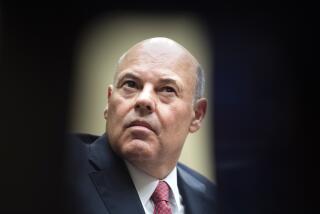Column: Trump again attacks the U.S. Postal Service with lies

- Share via
Of the myriad pathological fixations swirling around President Trump’s approach to governing, perhaps the oddest is his unrelenting hostility to the U.S. Postal Service.
Trump was at it again during a news briefing Tuesday, when, prompted by a question from a reporter, he hared off after the Postal Service and one of its most important customers, Amazon.com.
In his usual style, Trump disavowed responsibility for the Postal Service. “I’ll tell you who’s the demise of the Postal Service,” he said. “It’s these internet companies that give their stuff to the Postal Service — packages.” He asserted that the Postal Service loses money “every time they deliver a package for Amazon or these other internet companies that deliver.”
“These [internet] companies ... walk in and drop thousands of packages on the floor of the post office and say ‘deliver it.’ ”
— Trump gets the Postal Service wrong, again
He said that if the Postal Service raised prices “by actually a lot they could make money or break even.” He claimed he had no authority over the service, because it’s run by independent boards “appointed by other administrations.”
There’s a lot of misinformation to unpack there, so let’s roll up our sleeves and get started. Let’s keep in mind that Trump is attacking a government service specifically designed to provide universal delivery, binding together a nation from the remote Aleutian Islands of Alaska to Key West, from Lake of the Woods in frigid northern Minnesota to humid Brownsville, Texas.
Postal services are specifically enumerated in theConstitution (Article I). Put it all together, and the notion that they should be offered only at a profit or even at break-even costs is unsupported by law or tradition.
We don’t operate the military at a profit, or schools or any other public service; the notion that the Postal Service should be “run like a business,” as inviting that is to conservatives, is code for undermining a public good and letting private enterprise saddle up.
Trump blew up at the reporter’s repeating an assertion she attributed to Rep. Gerald E. Connolly ( D-Va.), that Trump killed a provision in a coronavirus rescue measure that would have given the Postal Service an emergency appropriation of $25 billion.
Trump is threatening the USPS with privatization, but that’s a terrible idea.
In the latest rescue package, the Postal Service only received a government-backed loan of up to $10 billion; postal officials have said it needs more to guarantee its continued operation past June.
As for Trump’s representations, although it’s true that the Postal Service is overseen by an independent board of governors, they’re all subject to presidential appointment. Currently the board has two vacancies and five members. Every one of the five was appointed by Trump.
The separate Postal Regulatory Commission has the power to set rates, which are Trump’s major bugaboo. The PRC has five members, of whom no more than three can be members of the same party. Of the current commissioners, three (two Democrats and a Republican) were appointed by Trump. The other two members are both Republicans.
Trump doesn’t appear to be up to speed on this. He said at the briefing, “We just got a chance to appoint a couple of people onto the commission, as I understand it, and that’s good.”
It’s hard to glean what he’s talking about. He made his three appointments in June 2018 and August and June of last year, which stretches the term “just” pretty far. The other two seats don’t open up until 2022. If Trump’s appointees don’t see things his way, he has no one to blame but himself.
Trump’s claims that a cut-rate deal with Amazon is at the heart of the service’s losses, that it loses money on every Amazon parcel or that it could move into the black if it jacked up prices by “a lot” aren’t based on facts.
More likely, they’re based on his animosity to Amazon, which is owned by Jeff Bezos, who separately owns the Washington Post. That sticks in Trump’s craw, because the Post produces some of the most searching, effective — and critical — coverage of his administration.
Indeed, Trump’s overt threats directed at Amazon have resulted in the blowup of a $10-billion contract for high-tech services that the Pentagon awarded to Microsoft. Amazon has sued to stop the award, asserting that its bid was superior and was lost to Microsoft only because of Trump’s interference. The deal is still tied up in court.
Amazon and other package delivery services, including those such as FedEx that aren’t internet merchants, have become a crucial customer base for the Postal Service. There’s no evidence from the service’s financial reports that these deliveries are made at a loss. Indeed, they account for an increasing share of its revenue.
In the first quarter of fiscal 2019 ended Dec. 31, the service reported, shipping and packages revenue increased by $146 million, or 2.3%, despite a volume decline of 84 million pieces, or 4.6%, compared to the same period a year earlier.
The growth in parcel revenue probably can’t make up for the sharp decline in first-class mail, which is one of the challenges faced by the Postal Service. Packages and shipping accounted for less than one-third of the service’s revenue of $71.3 billion in the last fiscal year. The service certainly could negotiate contracts at higher rates, but there are obvious limits, since parcel delivery isn’t a legal monopoly reserved to the Postal Service and at some level it would lose business to other parcel services or to a home-grown service such as one that Amazon has had in the works.
The U.S. Postal Service might rightly be considered the sick man of government agencies.
The actual terms of Amazon’s deal with the Postal Service aren’t public. But there’s reason to believe that the relationship is relatively efficient. According to Trump’s version, “these companies ... walk in and drop thousands of packages on the floor of the post office and say ‘deliver it.’”
But Amazon boasts a well-developed logistical capacity. By some accounts, the firm does a considerable amount of sorting before dropping off its parcels for the Postal Service to carry the last few miles.
No one disputes that the Postal Service loses billions of dollars a year — $8.8 billion in the last fiscal year. But the largest single contributor to its red ink is a mandate Congress imposed in 2006 that it prefund its retiree health coverage costs, a requirement no other government agency faces.
Connolly and fellow Democrats hoped to eliminate the mandate and the resulting overhang of debt via the coronavirus rescue package, but failed.
Trump hasn’t done anything to improve the Postal Service’s fortunes, nor has he shown that he understands its problems. As with so many issues, he could do everyone a favor by not talking about it.
More to Read
Inside the business of entertainment
The Wide Shot brings you news, analysis and insights on everything from streaming wars to production — and what it all means for the future.
You may occasionally receive promotional content from the Los Angeles Times.











